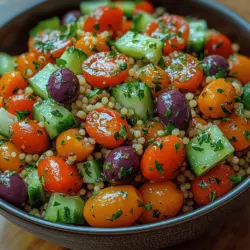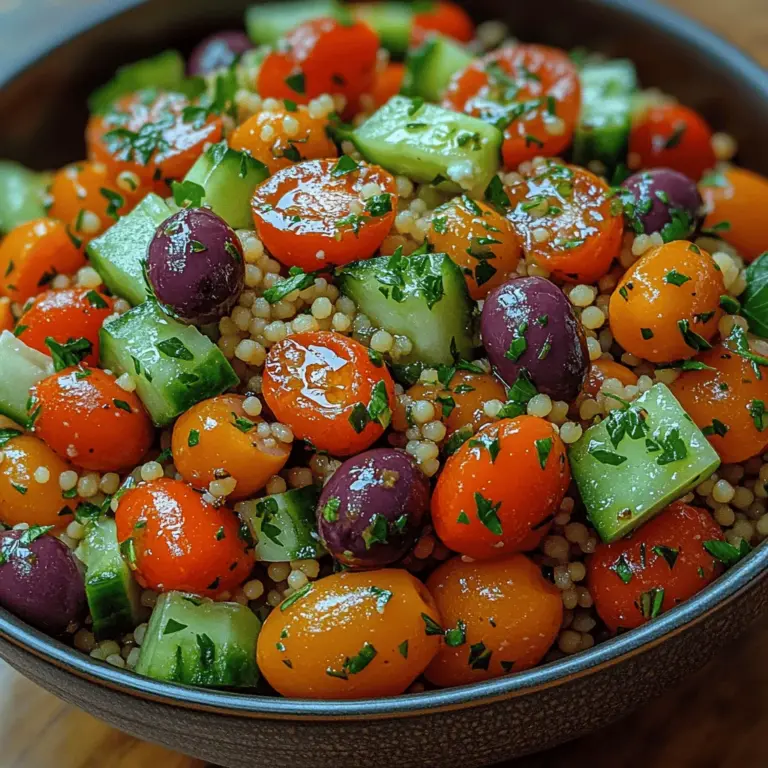Introduction
In today’s fast-paced world, finding nutritious and delicious meal options can be a challenge. Enter the Mediterranean Couscous Salad—a vibrant, fresh dish that not only tantalizes the taste buds but also delivers a plethora of health benefits. This salad combines colorful vegetables, protein-rich couscous, and a zesty dressing, making it the perfect addition to any meal or a delightful standalone dish.
Originating from the Mediterranean basin, this salad reflects the region’s rich culinary traditions, where fresh produce, wholesome grains, and bold flavors reign supreme. The Mediterranean diet is celebrated not just for its flavors but also for its numerous health benefits, promoting longevity and overall well-being. In this article, we will explore the ingredients, preparation method, and the cultural significance of this Mediterranean classic, ensuring that you can recreate it effortlessly in your kitchen.
Understanding the Essence of Mediterranean Cuisine
The Mediterranean diet is more than just a style of eating; it is a lifestyle that emphasizes whole, unprocessed foods. This diet is characterized by its abundance of fruits, vegetables, whole grains, legumes, nuts, and healthy fats, particularly olive oil. The Mediterranean region, which includes countries like Greece, Italy, and Spain, is known for its diverse culinary heritage, where each dish tells a story of local traditions and seasonal ingredients.
Exploring the Mediterranean Diet
The Mediterranean diet encourages the consumption of a variety of food groups, allowing for a balanced intake of essential nutrients. Central to this diet are whole grains, which serve as a foundation for many meals. Couscous, a staple in Moroccan cuisine, has become a popular addition to Mediterranean salads due to its versatility and ease of preparation.
Besides couscous, the diet incorporates legumes like chickpeas and beans, which provide protein and fiber, and a wide array of fresh vegetables that contribute vital vitamins and minerals. Healthy fats from sources like olive oil, nuts, and fish are also prevalent, promoting heart health and reducing the risk of chronic diseases.
Discussing the Health Benefits of Mediterranean Ingredients
The ingredients commonly found in Mediterranean dishes, including those in couscous salad, offer a multitude of health benefits. For instance, the high fiber content in vegetables and whole grains supports digestive health, while the antioxidants present in colorful fruits and vegetables help combat inflammation and oxidative stress.
Olive oil, a key component of Mediterranean cooking, is rich in monounsaturated fats and has been linked to lower cholesterol levels and reduced risk of heart disease. Feta cheese, another popular ingredient in Mediterranean salads, provides calcium and protein, making it an excellent addition for those looking to enhance their nutritional intake.
The Role of Fresh Vegetables and Herbs in Mediterranean Cooking
Fresh vegetables and herbs play a crucial role in Mediterranean cuisine, imparting flavor, color, and nutrients to dishes. Ingredients like tomatoes, cucumbers, bell peppers, and red onions not only add texture but also contribute to the overall freshness of the salad. Herbs such as parsley, mint, and basil infuse dishes with aromatic qualities, enhancing the eating experience.
The use of herbs and spices instead of excessive salt or heavy sauces is a hallmark of Mediterranean cooking, allowing for a flavor profile that is both vibrant and health-conscious. This approach not only highlights the natural flavors of the ingredients but also aligns with the principles of a balanced diet.
Ingredients Breakdown for Mediterranean Couscous Salad
To create a delicious Mediterranean Couscous Salad, it’s essential to understand the key components that make this dish both flavorful and nutritious.
Highlighting the Main Components
The primary ingredients in a Mediterranean Couscous Salad typically include:
– Couscous: The base of the salad, couscous is a quick-cooking grain made from semolina wheat. It serves as a blank canvas for various flavors and textures.
– Fresh Vegetables: Commonly used vegetables include cherry tomatoes, cucumbers, bell peppers, and red onions. These ingredients add crunch and color to the salad.
– Feta Cheese: This tangy cheese complements the fresh vegetables and adds a rich, creamy element to the dish.
– Olives: Kalamata or green olives provide a briny flavor that elevates the overall taste of the salad.
– Herbs: Fresh parsley and mint enhance the salad’s aroma and freshness.
– Dressing: A simple vinaigrette made with olive oil, lemon juice, salt, and pepper ties all the ingredients together.
The Nutritional Value of Couscous
Couscous is an excellent source of carbohydrates, making it a great energy-boosting grain. It is low in fat and contains a moderate amount of protein, making it a suitable option for those looking to maintain a balanced diet. Additionally, couscous is often enriched with vitamins and minerals, including B vitamins, iron, and magnesium, which contribute to overall health.
The Health Benefits of Olives and Feta Cheese
Olives are a staple in Mediterranean diets and are known for their numerous health benefits. They are rich in healthy fats, particularly oleic acid, which can help reduce inflammation and promote heart health. Additionally, olives are high in antioxidants, supporting cellular health and reducing the risk of chronic diseases.
Feta cheese, while adding a creamy texture to the salad, also provides essential nutrients such as calcium and protein. The fermentation process used to make feta cheese can also promote gut health by introducing beneficial bacteria. However, it is important to consume feta in moderation, as it can be high in sodium.
Importance of Fresh Herbs and Vegetables
Utilizing fresh herbs and vegetables is crucial in Mediterranean Couscous Salad, as they not only enhance the flavor but also provide essential vitamins and minerals. Fresh vegetables are typically packed with vitamins A and C, potassium, and dietary fiber, while herbs like parsley and mint are rich in antioxidants. Including a variety of colorful produce ensures a diverse intake of nutrients and keeps the dish visually appealing.
Step-by-Step Guide to Making Mediterranean Couscous Salad
Creating a Mediterranean Couscous Salad is a straightforward process that can be accomplished in just a few simple steps. Below, we will outline the essential steps and tips for preparing this delightful dish.
Cooking the Couscous
Importance of Using Vegetable Broth
To elevate the flavor of your couscous, consider using vegetable broth instead of water when cooking. This simple swap infuses the grains with additional depth and richness, enhancing the overall taste of the salad.
Tips for Achieving Perfectly Fluffy Couscous
1. Measure Accurately: Use a 1:1 ratio of couscous to liquid. For every cup of couscous, use one cup of broth.
2. Boil the Liquid: Bring the vegetable broth to a boil, then remove it from heat before adding the couscous.
3. Cover and Let Sit: After adding couscous to the boiling broth, cover the pot and let it sit for about 5 minutes to allow the grains to absorb the liquid.
4. Fluff with a Fork: Once the couscous has absorbed the liquid, use a fork to gently fluff the grains, ensuring they remain separate and light.
Preparing the Vegetables
How to Select the Freshest Produce
Choosing the freshest produce is vital for the best flavor and texture in your Mediterranean Couscous Salad. Look for vegetables that are vibrant in color, firm to the touch, and free from blemishes. Seasonal vegetables are often the freshest and most flavorful options.
Techniques for Chopping and Dicing
1. Wash Thoroughly: Always wash your vegetables under cold water to remove any dirt or pesticides.
2. Uniform Size: When chopping your vegetables, aim for uniform pieces. This not only makes for an aesthetically pleasing salad but also ensures even distribution of flavors.
3. Use a Sharp Knife: A sharp knife makes cutting easier and safer, reducing the risk of slipping.
Combining Ingredients
The Art of Mixing Flavors and Textures
Once you have cooked the couscous and prepared the vegetables, it’s time to combine the ingredients. Start by placing the fluffy couscous in a large mixing bowl. Gently fold in the diced vegetables, olives, and crumbled feta cheese. The key is to mix the ingredients without mashing them, preserving the distinct textures and flavors.
Suggestions for Ingredient Variations
Feel free to customize your Mediterranean Couscous Salad by incorporating different ingredients based on your preferences or what you have on hand. Some delicious variations include:
– Adding Protein: Include grilled chicken, shrimp, or chickpeas for an extra protein boost.
– Experimenting with Vegetables: Try adding artichoke hearts, avocados, or roasted red peppers for added flavor and nutrition.
– Incorporating Nuts: Toss in some toasted pine nuts or almonds for a crunchy texture.
In this first part of our article, we have explored the vibrant world of Mediterranean cuisine and the delicious Mediterranean Couscous Salad. We’ve broken down the essential ingredients and outlined the initial steps for creating this nutritious dish. In the subsequent sections, we will delve further into the preparation process and share tips for achieving the best results. Stay tuned for more culinary insights into this delightful salad!
{{image_2}}
Creating the Dressing
The dressing is a crucial component of the Mediterranean Couscous Salad, providing that essential burst of flavor that ties all the ingredients together. Achieving a balanced dressing is key; it should be neither too acidic nor too oily. A well-crafted dressing enhances the salad without overpowering it.
Importance of Balance in Dressings
When creating a dressing, consider the balance of acidity, sweetness, and fat. For a Mediterranean Couscous Salad, a classic vinaigrette often works wonders. The acidity from ingredients like lemon juice or vinegar brightens the dish, while olive oil adds richness and smoothness. A touch of sweetness from honey or maple syrup can help to round out the flavors, ensuring that no one element dominates the others.
Understanding the Role of Each Dressing Component
– Acid: Lemon juice or red wine vinegar not only adds brightness but also helps to tenderize the vegetables in the salad.
– Oil: Extra virgin olive oil is a staple in Mediterranean cooking. It contributes healthy fats and its own distinct flavor profile, enhancing the overall taste.
– Sweetness: A hint of honey or agave can balance the acidity, making the dressing more harmonious.
– Seasoning: Salt, pepper, and perhaps a pinch of garlic powder or mustard can elevate the flavor, making the dressing more complex.
Dressing the Salad
Once the dressing is prepared, it’s time to dress the salad properly to ensure an even coating that enhances each bite.
Techniques for Even Coating
1. Tossing: Place the salad ingredients in a large bowl and drizzle the dressing over the top. Use tongs or your hands to gently toss the salad, ensuring that each piece is lightly coated with the dressing.
2. Layering: If the ingredients are particularly delicate, consider layering. Start with the couscous, then add vegetables, and finally drizzle the dressing on top before lightly mixing.
3. Marinating: For an extra flavor boost, allow the dressed salad to sit for about 15-30 minutes before serving. This marination time allows the flavors to meld together beautifully.
The Effect of Temperature on Flavor Melding
Temperature plays a significant role in how flavors develop. If the salad is served cold, it can mask some of the dressing’s complexity. Letting the salad sit at room temperature for a short period before serving can enhance the overall flavor experience, allowing the ingredients to come together harmoniously.
Adding Fresh Herbs
Herbs are a vital addition to the Mediterranean Couscous Salad, offering freshness and depth.
Benefits of Using Fresh Versus Dried Herbs
While dried herbs can certainly be used in a pinch, fresh herbs elevate the dish. Fresh herbs such as parsley, cilantro, or mint provide vibrant flavor and a pop of color. They also release essential oils when chopped, which enhances their aromatic qualities and makes them more impactful in the dish.
How Herbs Enhance the Overall Dish
Herbs add complexity to the salad, contributing not just flavor but also nutritional benefits. For instance, parsley is rich in vitamins A, C, and K, while cilantro is known for its antioxidant properties. Incorporating a variety of herbs can create a more interesting flavor profile, making each bite of the salad unique.
Serving Suggestions
Presentation is key when serving Mediterranean Couscous Salad. Here are some tips to make your dish visually appealing:
Presentation Tips for an Appealing Dish
1. Color Contrast: Use a variety of colorful vegetables to create a vibrant salad. Red bell peppers, yellow cherry tomatoes, and fresh greens can make the dish pop.
2. Layering: When serving, layer the ingredients in a clear bowl to showcase the beautiful colors and textures.
3. Garnish: A sprinkle of fresh herbs on top just before serving not only adds color but also enhances the aroma of the dish.
4. Serving Bowl: Choose a large, shallow serving bowl that allows guests to easily help themselves.
Pairing Ideas with Other Mediterranean Dishes
This salad pairs wonderfully with various Mediterranean dishes. Consider serving it alongside grilled chicken, lamb kebabs, or roasted vegetables. For a vegetarian option, it can complement falafel or stuffed grape leaves. The versatility of the salad makes it suitable for various meals, from casual lunches to festive dinners.
The Versatility of Mediterranean Couscous Salad
One of the standout features of Mediterranean Couscous Salad is its versatility.
Serving as a Side Dish vs. Main Course
This salad can serve as both a refreshing side dish or a hearty main course. When served as a side, it complements grilled meats and fish beautifully. As a main dish, consider adding protein sources such as chickpeas, feta cheese, or grilled shrimp to make it more filling.
Adaptations for Different Dietary Preferences
The Mediterranean Couscous Salad can easily be adapted to accommodate various dietary preferences:
– Vegan: Leave out cheese and add extra beans or lentils for protein.
– Gluten-Free: Substitute traditional couscous with quinoa or millet, ensuring a gluten-free meal.
– Low-Carb: For a lower-carb option, consider using cauliflower couscous or spiralized vegetables.
Storage Tips for Leftovers and Meal Prep
If you have leftovers, store the salad in an airtight container in the refrigerator. The flavors will continue to meld, making it even tastier the next day. It’s best to keep the dressing separate until you’re ready to eat to maintain the salad’s crunch. This salad can last in the fridge for about 3-5 days, making it an excellent option for meal prep.
Cultural Significance of Couscous in Mediterranean Cuisine
Couscous has a rich cultural history in Mediterranean cuisine, with deep roots that vary across regions.
Historical Background of Couscous in Mediterranean Regions
Originating from North Africa, couscous has become a staple in Mediterranean diets. Traditionally made from semolina wheat, it has been a vital source of sustenance for centuries. The process of making couscous involves steaming, which is an age-old technique still cherished today.
Couscous in Various Mediterranean Cultures
Couscous is celebrated in many Mediterranean cultures, each adding its twist. In Morocco, couscous is often served with stews. In Italy, it may be found in seafood dishes, while in France, it often accompanies grilled meats. Each culture embraces couscous, showcasing its adaptability and significance.
The Evolution of Couscous Dishes Over Time
Over the years, couscous has evolved, incorporating different ingredients and flavors. From traditional recipes to modern interpretations like the Mediterranean Couscous Salad, this dish continues to be a canvas for creativity, reflecting the diverse tastes of the Mediterranean.
Conclusion
The Mediterranean Couscous Salad is not just a dish; it’s a celebration of flavors, culture, and healthy eating. By understanding the ingredients and preparation techniques, anyone can enjoy this delightful recipe that brings a taste of the Mediterranean to their table. This salad is perfect for any occasion, whether as a refreshing summer dish or a hearty addition to a winter meal. Embrace the vibrant flavors and health benefits of this Mediterranean classic, and let it inspire your culinary adventures!



